MGT701 Report: Evaluating Team Structure at Sunflower Foods
VerifiedAdded on 2023/06/10
|17
|4233
|283
Report
AI Summary
This report addresses the challenges faced by Sunflower Foods, a manufacturing plant experiencing low employee morale and productivity. The report, prepared for the Head of Human Capital, explores the implementation of a team-based structure as a potential solution. It begins by discussing the advantages and disadvantages of team structures, offering recommendations for their adoption. The report then delves into strategies for improving employee motivation and morale, referencing theories like Maslow's hierarchy of needs and McGregor's Theory X and Y. Finally, it identifies key elements for driving strategic change within the organization, focusing on listening, communicating, and recognizing employees. The report aims to provide a comprehensive analysis and actionable insights for enhancing productivity and fostering a positive work environment at Sunflower Foods.
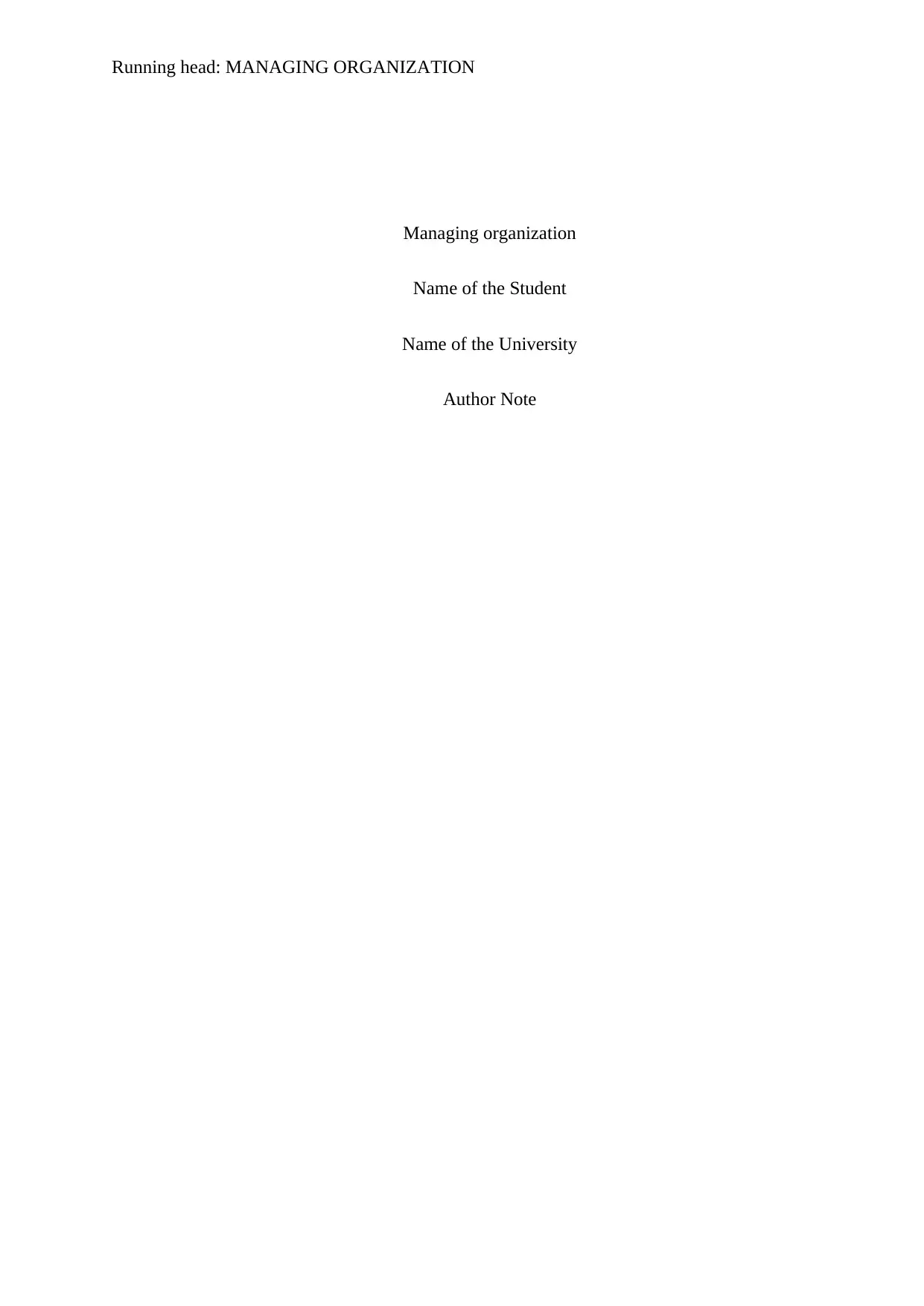
Running head: MANAGING ORGANIZATION
Managing organization
Name of the Student
Name of the University
Author Note
Managing organization
Name of the Student
Name of the University
Author Note
Paraphrase This Document
Need a fresh take? Get an instant paraphrase of this document with our AI Paraphraser
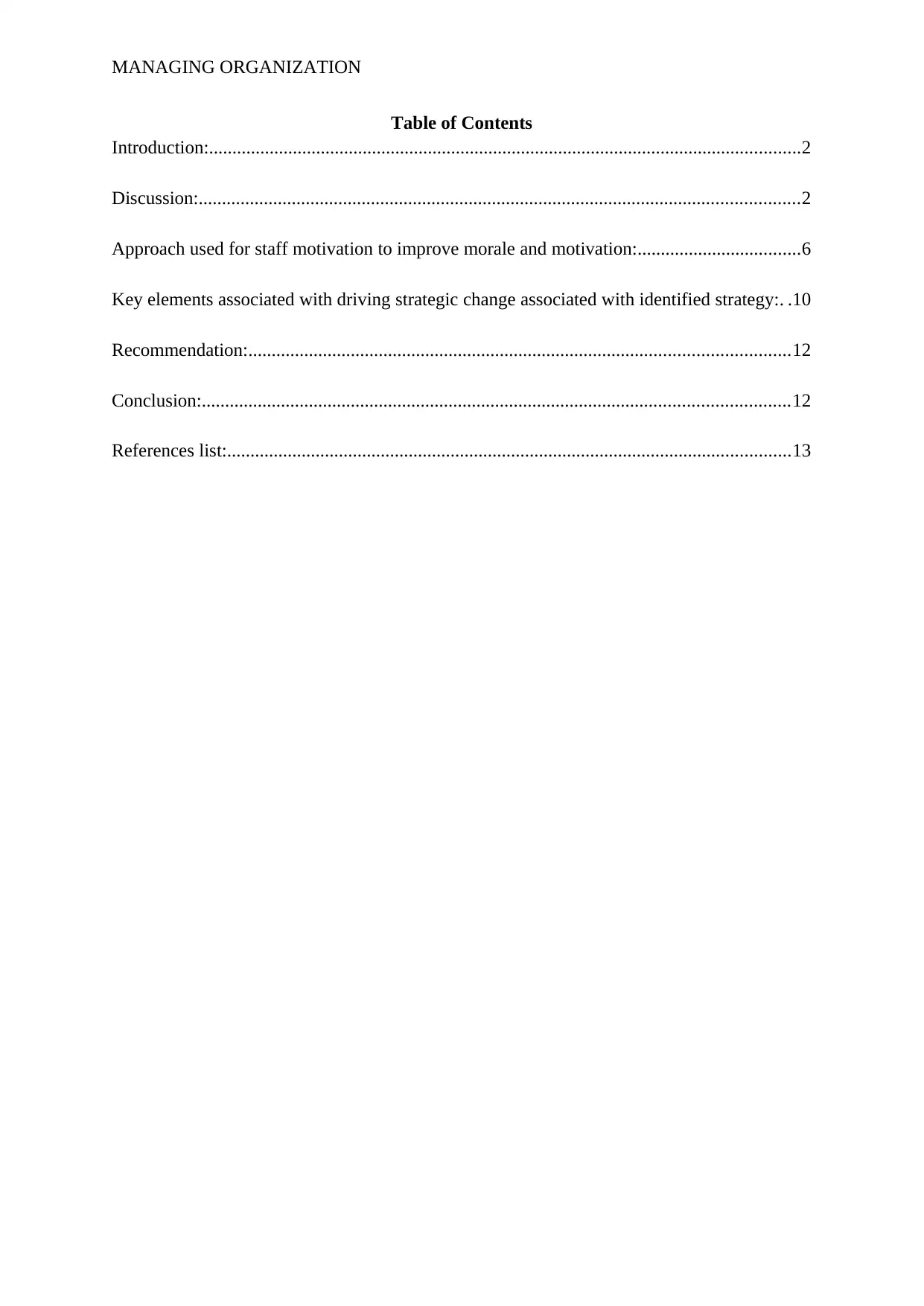
MANAGING ORGANIZATION
Table of Contents
Introduction:...............................................................................................................................2
Discussion:.................................................................................................................................2
Approach used for staff motivation to improve morale and motivation:...................................6
Key elements associated with driving strategic change associated with identified strategy:. .10
Recommendation:....................................................................................................................12
Conclusion:..............................................................................................................................12
References list:.........................................................................................................................13
Table of Contents
Introduction:...............................................................................................................................2
Discussion:.................................................................................................................................2
Approach used for staff motivation to improve morale and motivation:...................................6
Key elements associated with driving strategic change associated with identified strategy:. .10
Recommendation:....................................................................................................................12
Conclusion:..............................................................................................................................12
References list:.........................................................................................................................13
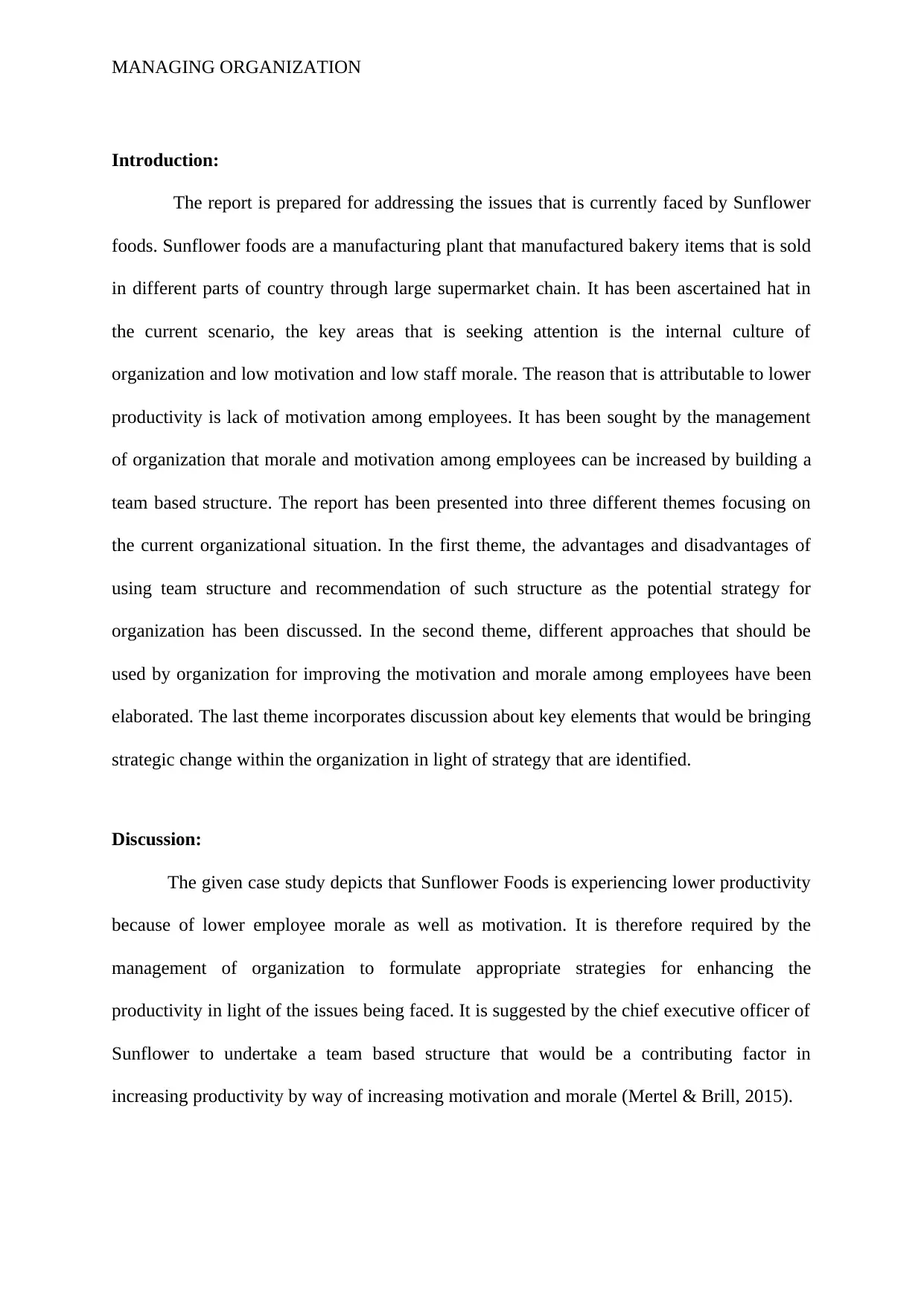
MANAGING ORGANIZATION
Introduction:
The report is prepared for addressing the issues that is currently faced by Sunflower
foods. Sunflower foods are a manufacturing plant that manufactured bakery items that is sold
in different parts of country through large supermarket chain. It has been ascertained hat in
the current scenario, the key areas that is seeking attention is the internal culture of
organization and low motivation and low staff morale. The reason that is attributable to lower
productivity is lack of motivation among employees. It has been sought by the management
of organization that morale and motivation among employees can be increased by building a
team based structure. The report has been presented into three different themes focusing on
the current organizational situation. In the first theme, the advantages and disadvantages of
using team structure and recommendation of such structure as the potential strategy for
organization has been discussed. In the second theme, different approaches that should be
used by organization for improving the motivation and morale among employees have been
elaborated. The last theme incorporates discussion about key elements that would be bringing
strategic change within the organization in light of strategy that are identified.
Discussion:
The given case study depicts that Sunflower Foods is experiencing lower productivity
because of lower employee morale as well as motivation. It is therefore required by the
management of organization to formulate appropriate strategies for enhancing the
productivity in light of the issues being faced. It is suggested by the chief executive officer of
Sunflower to undertake a team based structure that would be a contributing factor in
increasing productivity by way of increasing motivation and morale (Mertel & Brill, 2015).
Introduction:
The report is prepared for addressing the issues that is currently faced by Sunflower
foods. Sunflower foods are a manufacturing plant that manufactured bakery items that is sold
in different parts of country through large supermarket chain. It has been ascertained hat in
the current scenario, the key areas that is seeking attention is the internal culture of
organization and low motivation and low staff morale. The reason that is attributable to lower
productivity is lack of motivation among employees. It has been sought by the management
of organization that morale and motivation among employees can be increased by building a
team based structure. The report has been presented into three different themes focusing on
the current organizational situation. In the first theme, the advantages and disadvantages of
using team structure and recommendation of such structure as the potential strategy for
organization has been discussed. In the second theme, different approaches that should be
used by organization for improving the motivation and morale among employees have been
elaborated. The last theme incorporates discussion about key elements that would be bringing
strategic change within the organization in light of strategy that are identified.
Discussion:
The given case study depicts that Sunflower Foods is experiencing lower productivity
because of lower employee morale as well as motivation. It is therefore required by the
management of organization to formulate appropriate strategies for enhancing the
productivity in light of the issues being faced. It is suggested by the chief executive officer of
Sunflower to undertake a team based structure that would be a contributing factor in
increasing productivity by way of increasing motivation and morale (Mertel & Brill, 2015).
⊘ This is a preview!⊘
Do you want full access?
Subscribe today to unlock all pages.

Trusted by 1+ million students worldwide
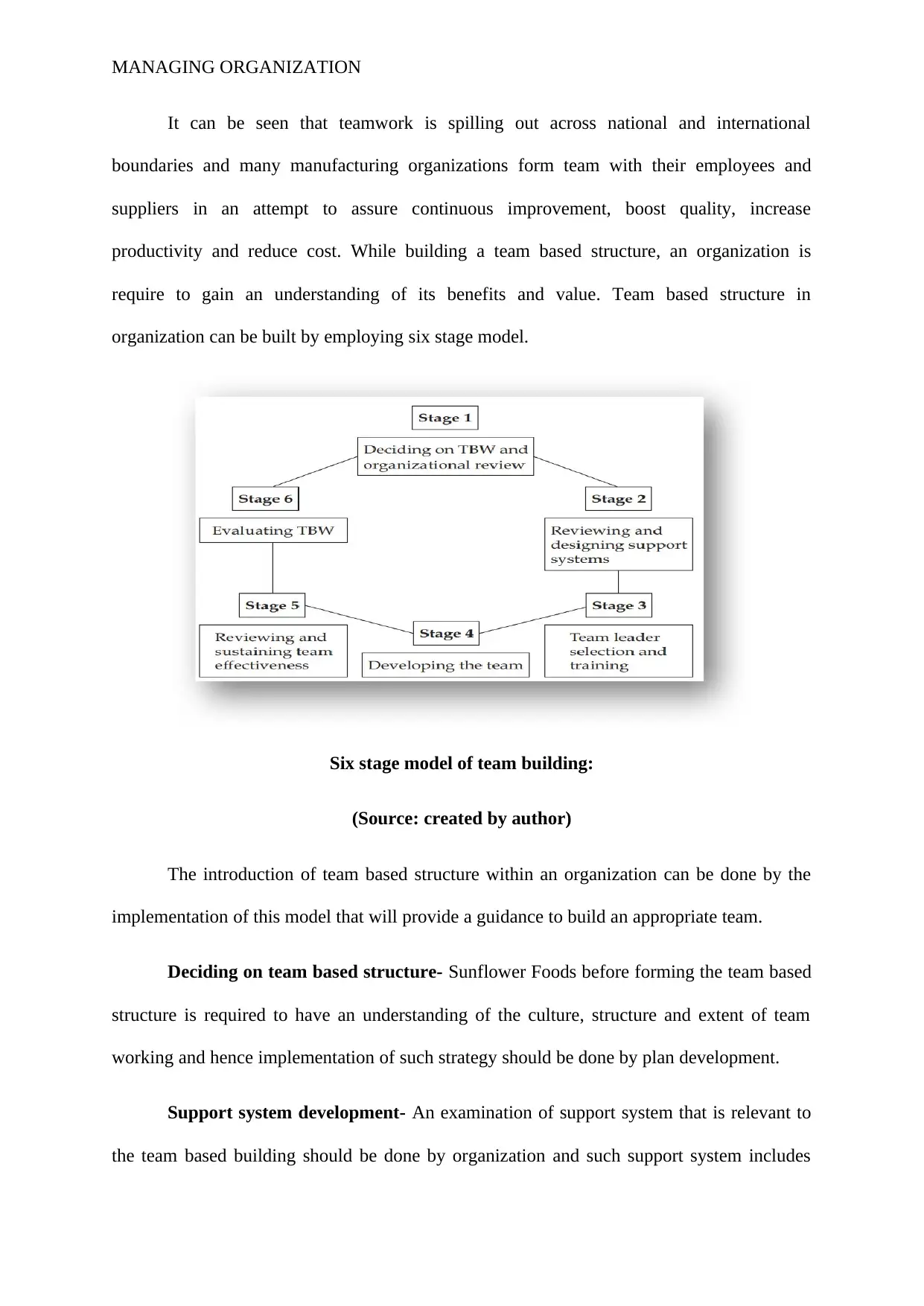
MANAGING ORGANIZATION
It can be seen that teamwork is spilling out across national and international
boundaries and many manufacturing organizations form team with their employees and
suppliers in an attempt to assure continuous improvement, boost quality, increase
productivity and reduce cost. While building a team based structure, an organization is
require to gain an understanding of its benefits and value. Team based structure in
organization can be built by employing six stage model.
Six stage model of team building:
(Source: created by author)
The introduction of team based structure within an organization can be done by the
implementation of this model that will provide a guidance to build an appropriate team.
Deciding on team based structure- Sunflower Foods before forming the team based
structure is required to have an understanding of the culture, structure and extent of team
working and hence implementation of such strategy should be done by plan development.
Support system development- An examination of support system that is relevant to
the team based building should be done by organization and such support system includes
It can be seen that teamwork is spilling out across national and international
boundaries and many manufacturing organizations form team with their employees and
suppliers in an attempt to assure continuous improvement, boost quality, increase
productivity and reduce cost. While building a team based structure, an organization is
require to gain an understanding of its benefits and value. Team based structure in
organization can be built by employing six stage model.
Six stage model of team building:
(Source: created by author)
The introduction of team based structure within an organization can be done by the
implementation of this model that will provide a guidance to build an appropriate team.
Deciding on team based structure- Sunflower Foods before forming the team based
structure is required to have an understanding of the culture, structure and extent of team
working and hence implementation of such strategy should be done by plan development.
Support system development- An examination of support system that is relevant to
the team based building should be done by organization and such support system includes
Paraphrase This Document
Need a fresh take? Get an instant paraphrase of this document with our AI Paraphraser
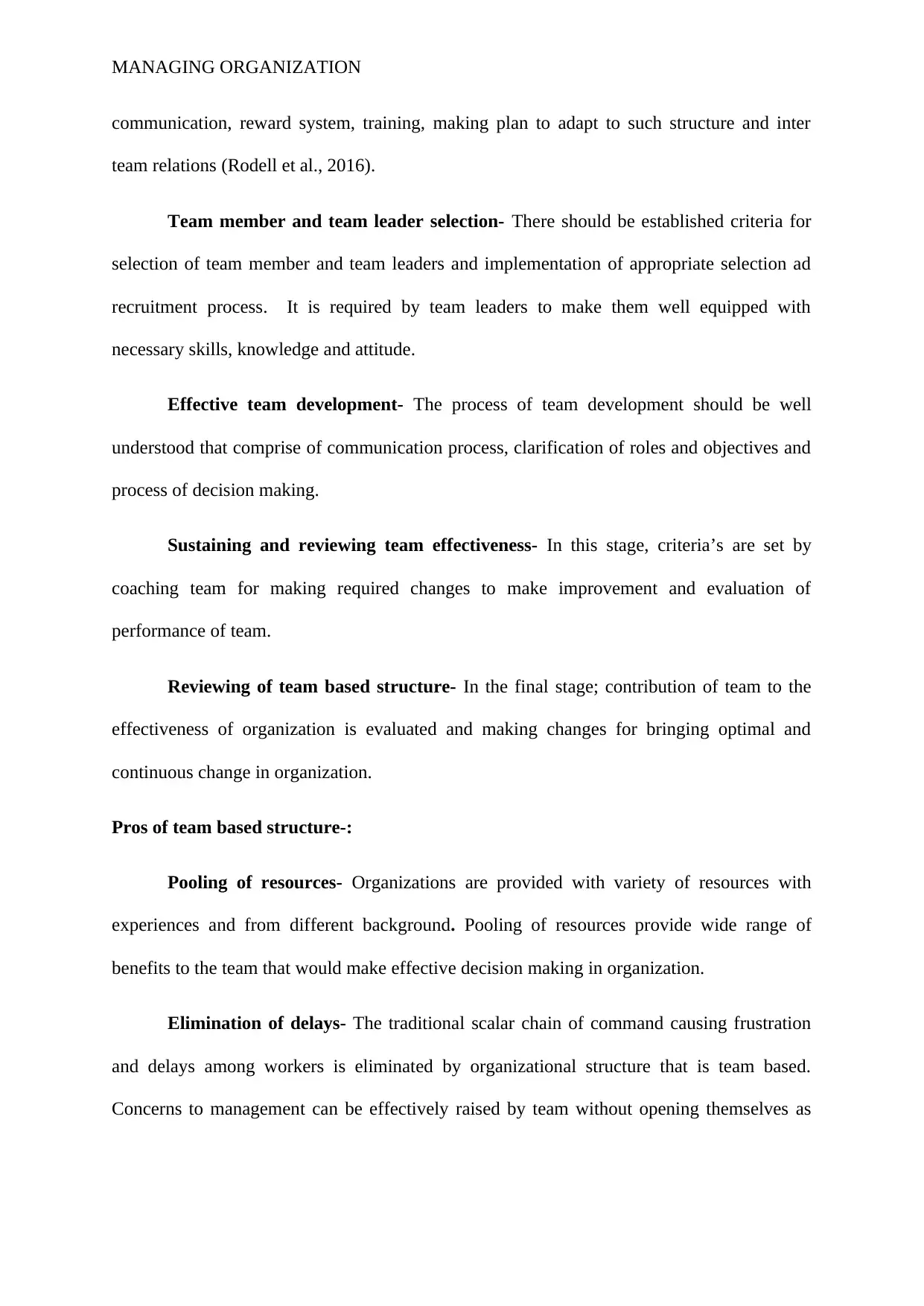
MANAGING ORGANIZATION
communication, reward system, training, making plan to adapt to such structure and inter
team relations (Rodell et al., 2016).
Team member and team leader selection- There should be established criteria for
selection of team member and team leaders and implementation of appropriate selection ad
recruitment process. It is required by team leaders to make them well equipped with
necessary skills, knowledge and attitude.
Effective team development- The process of team development should be well
understood that comprise of communication process, clarification of roles and objectives and
process of decision making.
Sustaining and reviewing team effectiveness- In this stage, criteria’s are set by
coaching team for making required changes to make improvement and evaluation of
performance of team.
Reviewing of team based structure- In the final stage; contribution of team to the
effectiveness of organization is evaluated and making changes for bringing optimal and
continuous change in organization.
Pros of team based structure-:
Pooling of resources- Organizations are provided with variety of resources with
experiences and from different background. Pooling of resources provide wide range of
benefits to the team that would make effective decision making in organization.
Elimination of delays- The traditional scalar chain of command causing frustration
and delays among workers is eliminated by organizational structure that is team based.
Concerns to management can be effectively raised by team without opening themselves as
communication, reward system, training, making plan to adapt to such structure and inter
team relations (Rodell et al., 2016).
Team member and team leader selection- There should be established criteria for
selection of team member and team leaders and implementation of appropriate selection ad
recruitment process. It is required by team leaders to make them well equipped with
necessary skills, knowledge and attitude.
Effective team development- The process of team development should be well
understood that comprise of communication process, clarification of roles and objectives and
process of decision making.
Sustaining and reviewing team effectiveness- In this stage, criteria’s are set by
coaching team for making required changes to make improvement and evaluation of
performance of team.
Reviewing of team based structure- In the final stage; contribution of team to the
effectiveness of organization is evaluated and making changes for bringing optimal and
continuous change in organization.
Pros of team based structure-:
Pooling of resources- Organizations are provided with variety of resources with
experiences and from different background. Pooling of resources provide wide range of
benefits to the team that would make effective decision making in organization.
Elimination of delays- The traditional scalar chain of command causing frustration
and delays among workers is eliminated by organizational structure that is team based.
Concerns to management can be effectively raised by team without opening themselves as
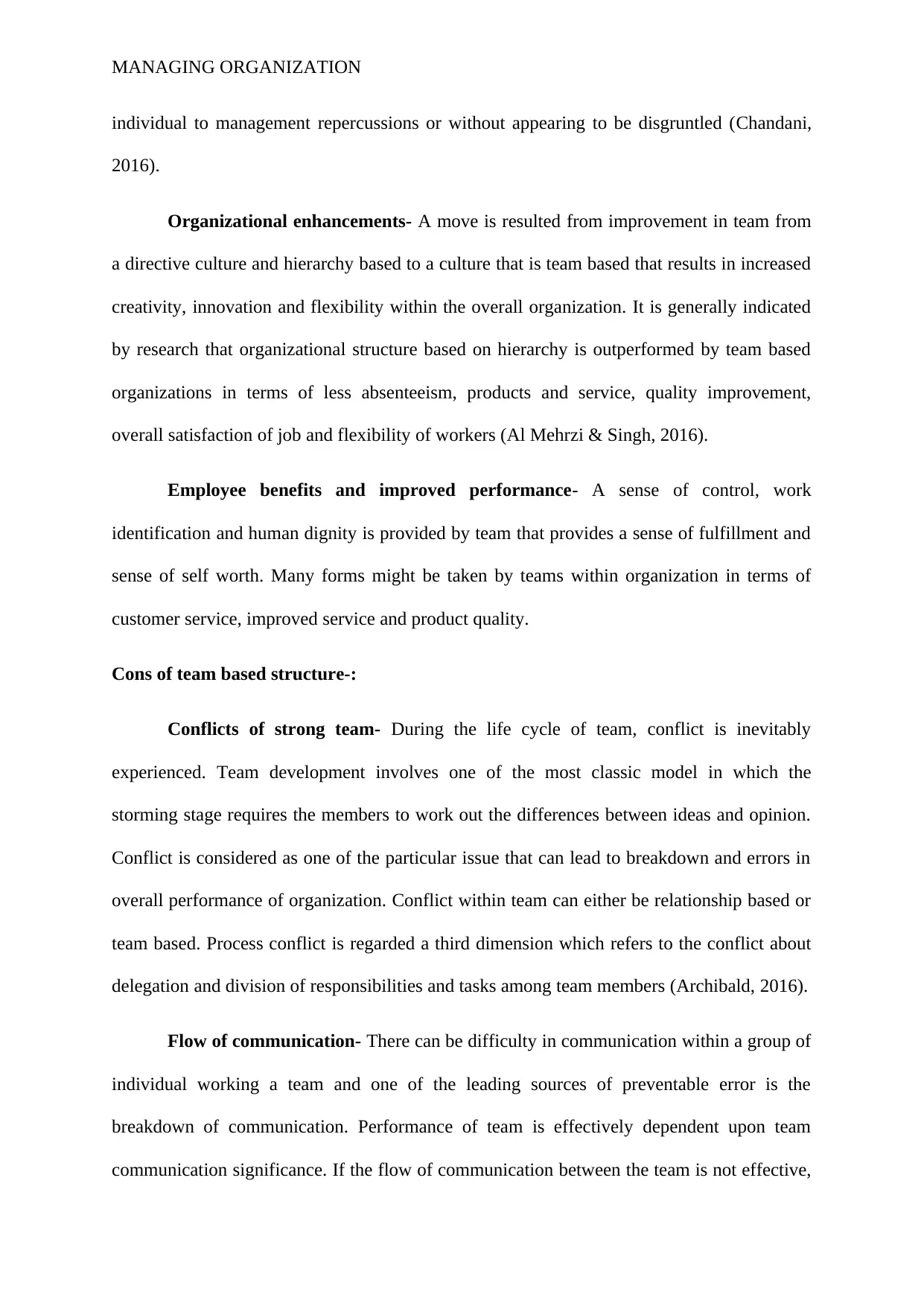
MANAGING ORGANIZATION
individual to management repercussions or without appearing to be disgruntled (Chandani,
2016).
Organizational enhancements- A move is resulted from improvement in team from
a directive culture and hierarchy based to a culture that is team based that results in increased
creativity, innovation and flexibility within the overall organization. It is generally indicated
by research that organizational structure based on hierarchy is outperformed by team based
organizations in terms of less absenteeism, products and service, quality improvement,
overall satisfaction of job and flexibility of workers (Al Mehrzi & Singh, 2016).
Employee benefits and improved performance- A sense of control, work
identification and human dignity is provided by team that provides a sense of fulfillment and
sense of self worth. Many forms might be taken by teams within organization in terms of
customer service, improved service and product quality.
Cons of team based structure-:
Conflicts of strong team- During the life cycle of team, conflict is inevitably
experienced. Team development involves one of the most classic model in which the
storming stage requires the members to work out the differences between ideas and opinion.
Conflict is considered as one of the particular issue that can lead to breakdown and errors in
overall performance of organization. Conflict within team can either be relationship based or
team based. Process conflict is regarded a third dimension which refers to the conflict about
delegation and division of responsibilities and tasks among team members (Archibald, 2016).
Flow of communication- There can be difficulty in communication within a group of
individual working a team and one of the leading sources of preventable error is the
breakdown of communication. Performance of team is effectively dependent upon team
communication significance. If the flow of communication between the team is not effective,
individual to management repercussions or without appearing to be disgruntled (Chandani,
2016).
Organizational enhancements- A move is resulted from improvement in team from
a directive culture and hierarchy based to a culture that is team based that results in increased
creativity, innovation and flexibility within the overall organization. It is generally indicated
by research that organizational structure based on hierarchy is outperformed by team based
organizations in terms of less absenteeism, products and service, quality improvement,
overall satisfaction of job and flexibility of workers (Al Mehrzi & Singh, 2016).
Employee benefits and improved performance- A sense of control, work
identification and human dignity is provided by team that provides a sense of fulfillment and
sense of self worth. Many forms might be taken by teams within organization in terms of
customer service, improved service and product quality.
Cons of team based structure-:
Conflicts of strong team- During the life cycle of team, conflict is inevitably
experienced. Team development involves one of the most classic model in which the
storming stage requires the members to work out the differences between ideas and opinion.
Conflict is considered as one of the particular issue that can lead to breakdown and errors in
overall performance of organization. Conflict within team can either be relationship based or
team based. Process conflict is regarded a third dimension which refers to the conflict about
delegation and division of responsibilities and tasks among team members (Archibald, 2016).
Flow of communication- There can be difficulty in communication within a group of
individual working a team and one of the leading sources of preventable error is the
breakdown of communication. Performance of team is effectively dependent upon team
communication significance. If the flow of communication between the team is not effective,
⊘ This is a preview!⊘
Do you want full access?
Subscribe today to unlock all pages.

Trusted by 1+ million students worldwide
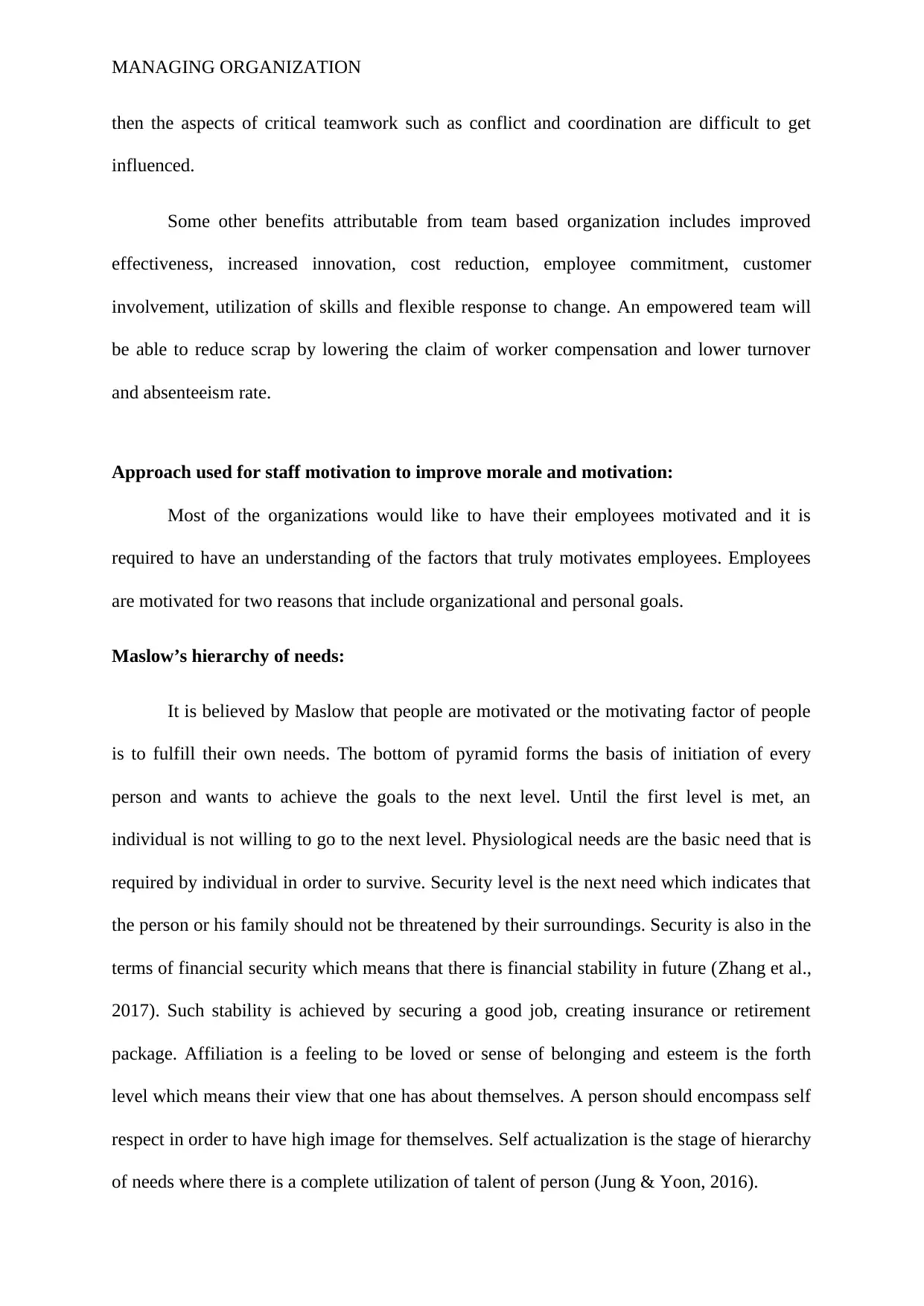
MANAGING ORGANIZATION
then the aspects of critical teamwork such as conflict and coordination are difficult to get
influenced.
Some other benefits attributable from team based organization includes improved
effectiveness, increased innovation, cost reduction, employee commitment, customer
involvement, utilization of skills and flexible response to change. An empowered team will
be able to reduce scrap by lowering the claim of worker compensation and lower turnover
and absenteeism rate.
Approach used for staff motivation to improve morale and motivation:
Most of the organizations would like to have their employees motivated and it is
required to have an understanding of the factors that truly motivates employees. Employees
are motivated for two reasons that include organizational and personal goals.
Maslow’s hierarchy of needs:
It is believed by Maslow that people are motivated or the motivating factor of people
is to fulfill their own needs. The bottom of pyramid forms the basis of initiation of every
person and wants to achieve the goals to the next level. Until the first level is met, an
individual is not willing to go to the next level. Physiological needs are the basic need that is
required by individual in order to survive. Security level is the next need which indicates that
the person or his family should not be threatened by their surroundings. Security is also in the
terms of financial security which means that there is financial stability in future (Zhang et al.,
2017). Such stability is achieved by securing a good job, creating insurance or retirement
package. Affiliation is a feeling to be loved or sense of belonging and esteem is the forth
level which means their view that one has about themselves. A person should encompass self
respect in order to have high image for themselves. Self actualization is the stage of hierarchy
of needs where there is a complete utilization of talent of person (Jung & Yoon, 2016).
then the aspects of critical teamwork such as conflict and coordination are difficult to get
influenced.
Some other benefits attributable from team based organization includes improved
effectiveness, increased innovation, cost reduction, employee commitment, customer
involvement, utilization of skills and flexible response to change. An empowered team will
be able to reduce scrap by lowering the claim of worker compensation and lower turnover
and absenteeism rate.
Approach used for staff motivation to improve morale and motivation:
Most of the organizations would like to have their employees motivated and it is
required to have an understanding of the factors that truly motivates employees. Employees
are motivated for two reasons that include organizational and personal goals.
Maslow’s hierarchy of needs:
It is believed by Maslow that people are motivated or the motivating factor of people
is to fulfill their own needs. The bottom of pyramid forms the basis of initiation of every
person and wants to achieve the goals to the next level. Until the first level is met, an
individual is not willing to go to the next level. Physiological needs are the basic need that is
required by individual in order to survive. Security level is the next need which indicates that
the person or his family should not be threatened by their surroundings. Security is also in the
terms of financial security which means that there is financial stability in future (Zhang et al.,
2017). Such stability is achieved by securing a good job, creating insurance or retirement
package. Affiliation is a feeling to be loved or sense of belonging and esteem is the forth
level which means their view that one has about themselves. A person should encompass self
respect in order to have high image for themselves. Self actualization is the stage of hierarchy
of needs where there is a complete utilization of talent of person (Jung & Yoon, 2016).
Paraphrase This Document
Need a fresh take? Get an instant paraphrase of this document with our AI Paraphraser
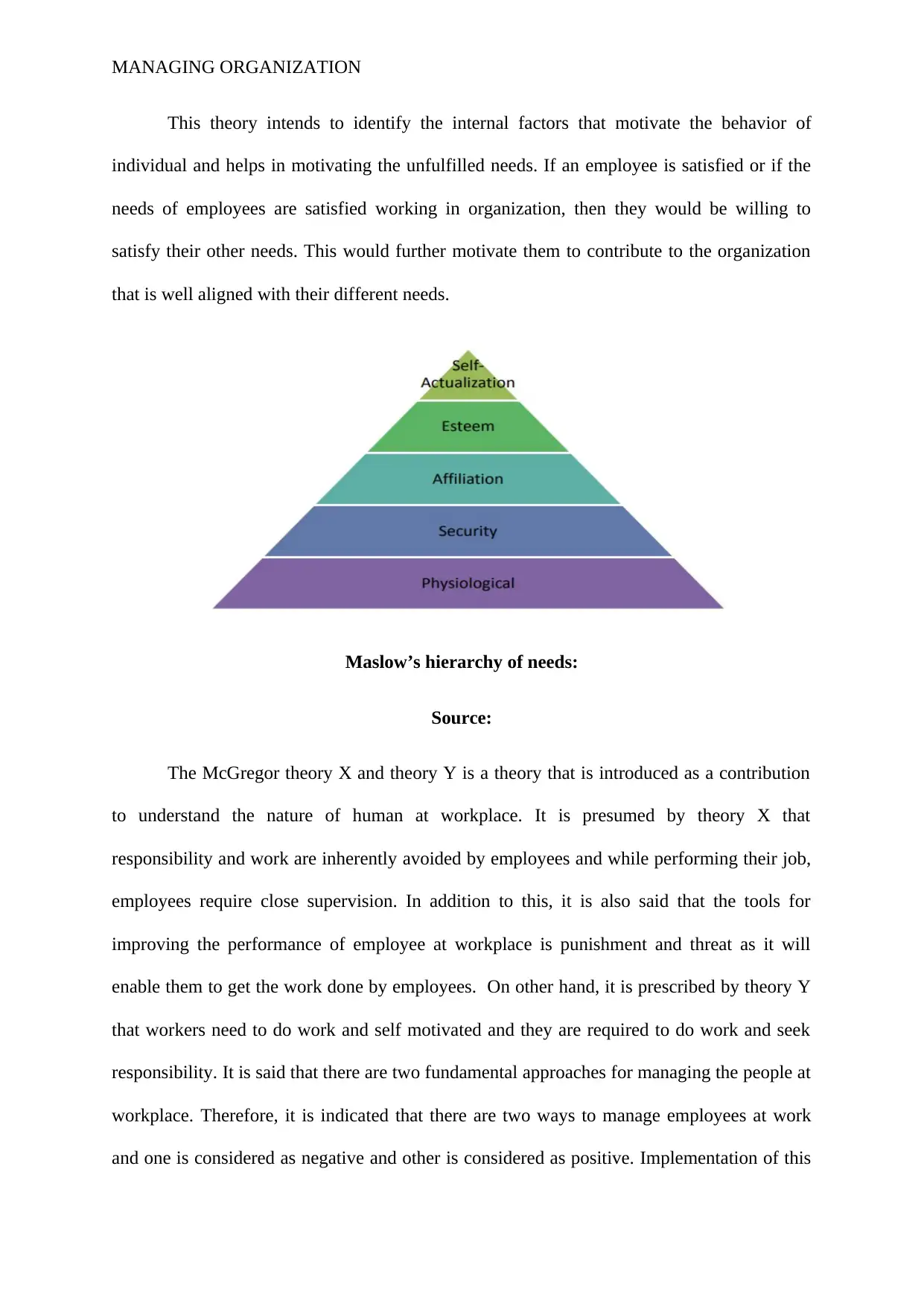
MANAGING ORGANIZATION
This theory intends to identify the internal factors that motivate the behavior of
individual and helps in motivating the unfulfilled needs. If an employee is satisfied or if the
needs of employees are satisfied working in organization, then they would be willing to
satisfy their other needs. This would further motivate them to contribute to the organization
that is well aligned with their different needs.
Maslow’s hierarchy of needs:
Source:
The McGregor theory X and theory Y is a theory that is introduced as a contribution
to understand the nature of human at workplace. It is presumed by theory X that
responsibility and work are inherently avoided by employees and while performing their job,
employees require close supervision. In addition to this, it is also said that the tools for
improving the performance of employee at workplace is punishment and threat as it will
enable them to get the work done by employees. On other hand, it is prescribed by theory Y
that workers need to do work and self motivated and they are required to do work and seek
responsibility. It is said that there are two fundamental approaches for managing the people at
workplace. Therefore, it is indicated that there are two ways to manage employees at work
and one is considered as negative and other is considered as positive. Implementation of this
This theory intends to identify the internal factors that motivate the behavior of
individual and helps in motivating the unfulfilled needs. If an employee is satisfied or if the
needs of employees are satisfied working in organization, then they would be willing to
satisfy their other needs. This would further motivate them to contribute to the organization
that is well aligned with their different needs.
Maslow’s hierarchy of needs:
Source:
The McGregor theory X and theory Y is a theory that is introduced as a contribution
to understand the nature of human at workplace. It is presumed by theory X that
responsibility and work are inherently avoided by employees and while performing their job,
employees require close supervision. In addition to this, it is also said that the tools for
improving the performance of employee at workplace is punishment and threat as it will
enable them to get the work done by employees. On other hand, it is prescribed by theory Y
that workers need to do work and self motivated and they are required to do work and seek
responsibility. It is said that there are two fundamental approaches for managing the people at
workplace. Therefore, it is indicated that there are two ways to manage employees at work
and one is considered as negative and other is considered as positive. Implementation of this
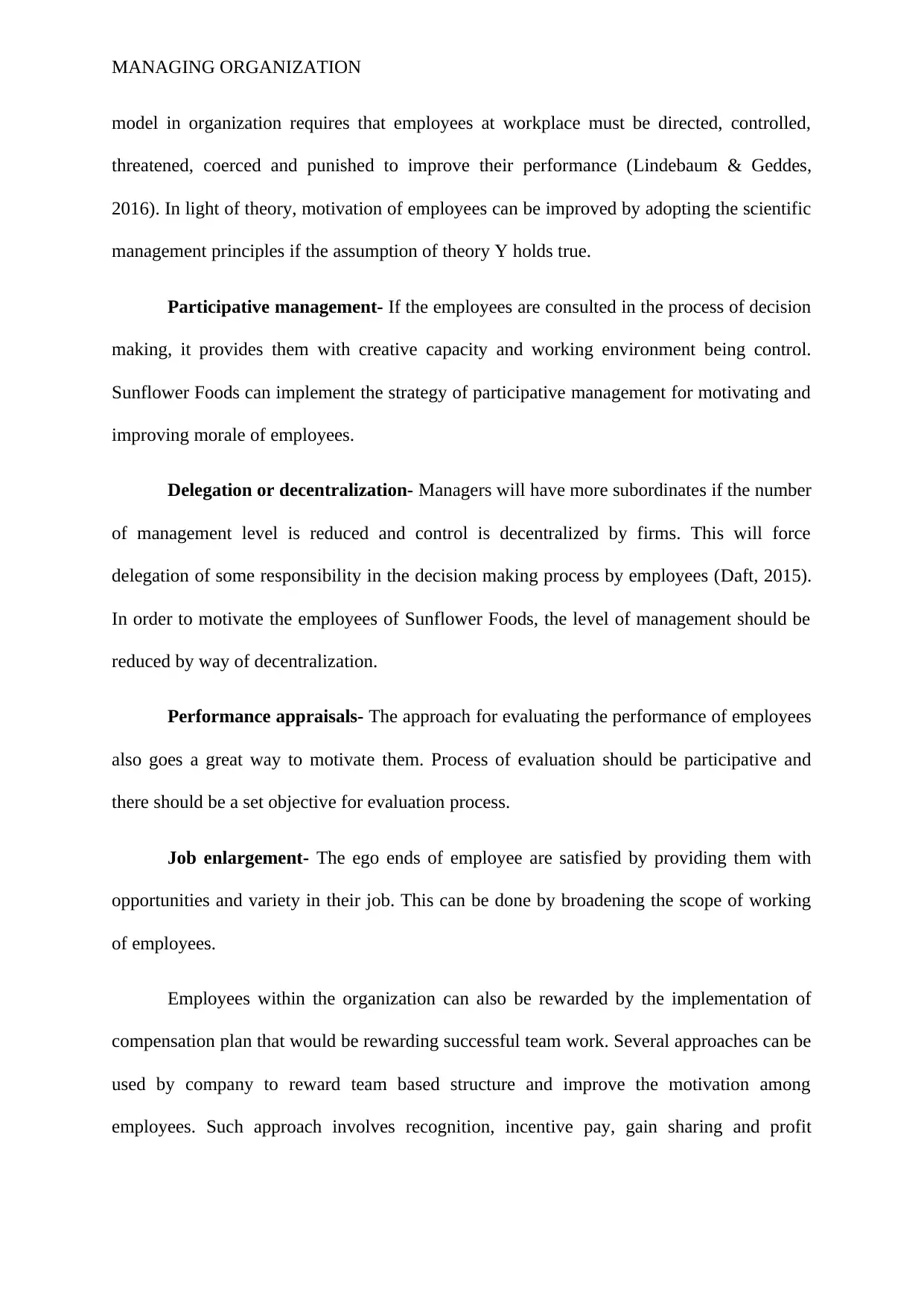
MANAGING ORGANIZATION
model in organization requires that employees at workplace must be directed, controlled,
threatened, coerced and punished to improve their performance (Lindebaum & Geddes,
2016). In light of theory, motivation of employees can be improved by adopting the scientific
management principles if the assumption of theory Y holds true.
Participative management- If the employees are consulted in the process of decision
making, it provides them with creative capacity and working environment being control.
Sunflower Foods can implement the strategy of participative management for motivating and
improving morale of employees.
Delegation or decentralization- Managers will have more subordinates if the number
of management level is reduced and control is decentralized by firms. This will force
delegation of some responsibility in the decision making process by employees (Daft, 2015).
In order to motivate the employees of Sunflower Foods, the level of management should be
reduced by way of decentralization.
Performance appraisals- The approach for evaluating the performance of employees
also goes a great way to motivate them. Process of evaluation should be participative and
there should be a set objective for evaluation process.
Job enlargement- The ego ends of employee are satisfied by providing them with
opportunities and variety in their job. This can be done by broadening the scope of working
of employees.
Employees within the organization can also be rewarded by the implementation of
compensation plan that would be rewarding successful team work. Several approaches can be
used by company to reward team based structure and improve the motivation among
employees. Such approach involves recognition, incentive pay, gain sharing and profit
model in organization requires that employees at workplace must be directed, controlled,
threatened, coerced and punished to improve their performance (Lindebaum & Geddes,
2016). In light of theory, motivation of employees can be improved by adopting the scientific
management principles if the assumption of theory Y holds true.
Participative management- If the employees are consulted in the process of decision
making, it provides them with creative capacity and working environment being control.
Sunflower Foods can implement the strategy of participative management for motivating and
improving morale of employees.
Delegation or decentralization- Managers will have more subordinates if the number
of management level is reduced and control is decentralized by firms. This will force
delegation of some responsibility in the decision making process by employees (Daft, 2015).
In order to motivate the employees of Sunflower Foods, the level of management should be
reduced by way of decentralization.
Performance appraisals- The approach for evaluating the performance of employees
also goes a great way to motivate them. Process of evaluation should be participative and
there should be a set objective for evaluation process.
Job enlargement- The ego ends of employee are satisfied by providing them with
opportunities and variety in their job. This can be done by broadening the scope of working
of employees.
Employees within the organization can also be rewarded by the implementation of
compensation plan that would be rewarding successful team work. Several approaches can be
used by company to reward team based structure and improve the motivation among
employees. Such approach involves recognition, incentive pay, gain sharing and profit
⊘ This is a preview!⊘
Do you want full access?
Subscribe today to unlock all pages.

Trusted by 1+ million students worldwide
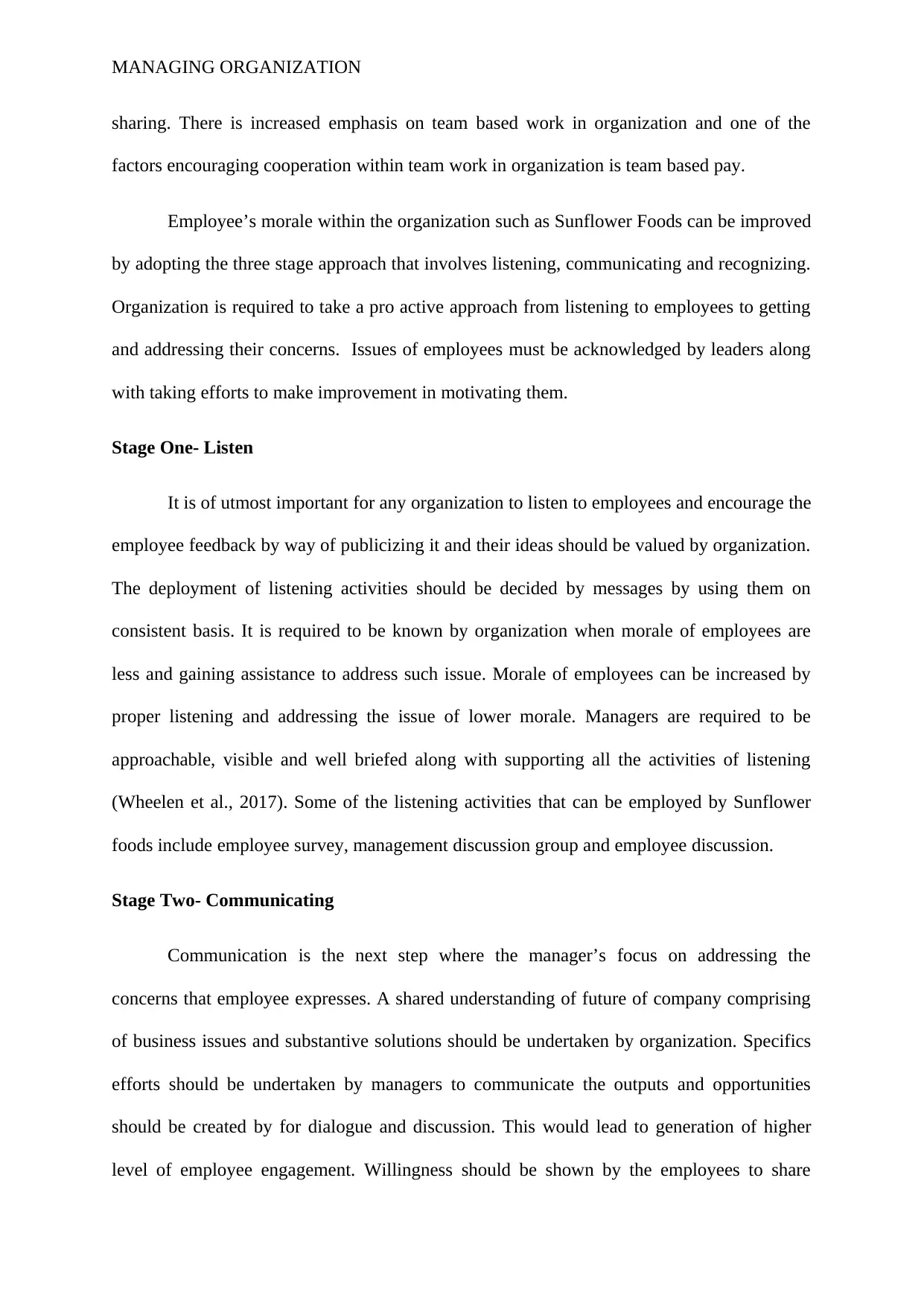
MANAGING ORGANIZATION
sharing. There is increased emphasis on team based work in organization and one of the
factors encouraging cooperation within team work in organization is team based pay.
Employee’s morale within the organization such as Sunflower Foods can be improved
by adopting the three stage approach that involves listening, communicating and recognizing.
Organization is required to take a pro active approach from listening to employees to getting
and addressing their concerns. Issues of employees must be acknowledged by leaders along
with taking efforts to make improvement in motivating them.
Stage One- Listen
It is of utmost important for any organization to listen to employees and encourage the
employee feedback by way of publicizing it and their ideas should be valued by organization.
The deployment of listening activities should be decided by messages by using them on
consistent basis. It is required to be known by organization when morale of employees are
less and gaining assistance to address such issue. Morale of employees can be increased by
proper listening and addressing the issue of lower morale. Managers are required to be
approachable, visible and well briefed along with supporting all the activities of listening
(Wheelen et al., 2017). Some of the listening activities that can be employed by Sunflower
foods include employee survey, management discussion group and employee discussion.
Stage Two- Communicating
Communication is the next step where the manager’s focus on addressing the
concerns that employee expresses. A shared understanding of future of company comprising
of business issues and substantive solutions should be undertaken by organization. Specifics
efforts should be undertaken by managers to communicate the outputs and opportunities
should be created by for dialogue and discussion. This would lead to generation of higher
level of employee engagement. Willingness should be shown by the employees to share
sharing. There is increased emphasis on team based work in organization and one of the
factors encouraging cooperation within team work in organization is team based pay.
Employee’s morale within the organization such as Sunflower Foods can be improved
by adopting the three stage approach that involves listening, communicating and recognizing.
Organization is required to take a pro active approach from listening to employees to getting
and addressing their concerns. Issues of employees must be acknowledged by leaders along
with taking efforts to make improvement in motivating them.
Stage One- Listen
It is of utmost important for any organization to listen to employees and encourage the
employee feedback by way of publicizing it and their ideas should be valued by organization.
The deployment of listening activities should be decided by messages by using them on
consistent basis. It is required to be known by organization when morale of employees are
less and gaining assistance to address such issue. Morale of employees can be increased by
proper listening and addressing the issue of lower morale. Managers are required to be
approachable, visible and well briefed along with supporting all the activities of listening
(Wheelen et al., 2017). Some of the listening activities that can be employed by Sunflower
foods include employee survey, management discussion group and employee discussion.
Stage Two- Communicating
Communication is the next step where the manager’s focus on addressing the
concerns that employee expresses. A shared understanding of future of company comprising
of business issues and substantive solutions should be undertaken by organization. Specifics
efforts should be undertaken by managers to communicate the outputs and opportunities
should be created by for dialogue and discussion. This would lead to generation of higher
level of employee engagement. Willingness should be shown by the employees to share
Paraphrase This Document
Need a fresh take? Get an instant paraphrase of this document with our AI Paraphraser
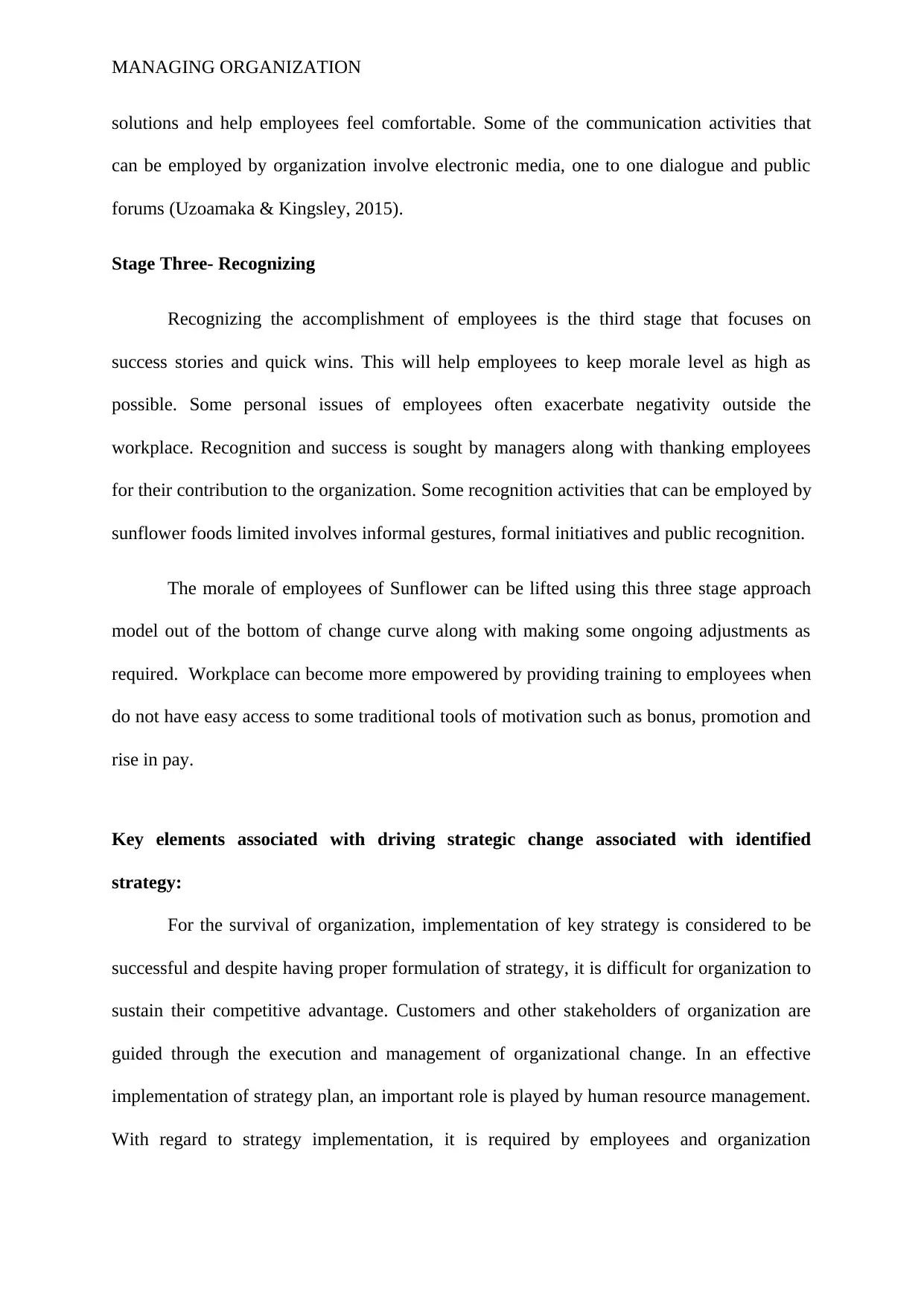
MANAGING ORGANIZATION
solutions and help employees feel comfortable. Some of the communication activities that
can be employed by organization involve electronic media, one to one dialogue and public
forums (Uzoamaka & Kingsley, 2015).
Stage Three- Recognizing
Recognizing the accomplishment of employees is the third stage that focuses on
success stories and quick wins. This will help employees to keep morale level as high as
possible. Some personal issues of employees often exacerbate negativity outside the
workplace. Recognition and success is sought by managers along with thanking employees
for their contribution to the organization. Some recognition activities that can be employed by
sunflower foods limited involves informal gestures, formal initiatives and public recognition.
The morale of employees of Sunflower can be lifted using this three stage approach
model out of the bottom of change curve along with making some ongoing adjustments as
required. Workplace can become more empowered by providing training to employees when
do not have easy access to some traditional tools of motivation such as bonus, promotion and
rise in pay.
Key elements associated with driving strategic change associated with identified
strategy:
For the survival of organization, implementation of key strategy is considered to be
successful and despite having proper formulation of strategy, it is difficult for organization to
sustain their competitive advantage. Customers and other stakeholders of organization are
guided through the execution and management of organizational change. In an effective
implementation of strategy plan, an important role is played by human resource management.
With regard to strategy implementation, it is required by employees and organization
solutions and help employees feel comfortable. Some of the communication activities that
can be employed by organization involve electronic media, one to one dialogue and public
forums (Uzoamaka & Kingsley, 2015).
Stage Three- Recognizing
Recognizing the accomplishment of employees is the third stage that focuses on
success stories and quick wins. This will help employees to keep morale level as high as
possible. Some personal issues of employees often exacerbate negativity outside the
workplace. Recognition and success is sought by managers along with thanking employees
for their contribution to the organization. Some recognition activities that can be employed by
sunflower foods limited involves informal gestures, formal initiatives and public recognition.
The morale of employees of Sunflower can be lifted using this three stage approach
model out of the bottom of change curve along with making some ongoing adjustments as
required. Workplace can become more empowered by providing training to employees when
do not have easy access to some traditional tools of motivation such as bonus, promotion and
rise in pay.
Key elements associated with driving strategic change associated with identified
strategy:
For the survival of organization, implementation of key strategy is considered to be
successful and despite having proper formulation of strategy, it is difficult for organization to
sustain their competitive advantage. Customers and other stakeholders of organization are
guided through the execution and management of organizational change. In an effective
implementation of strategy plan, an important role is played by human resource management.
With regard to strategy implementation, it is required by employees and organization
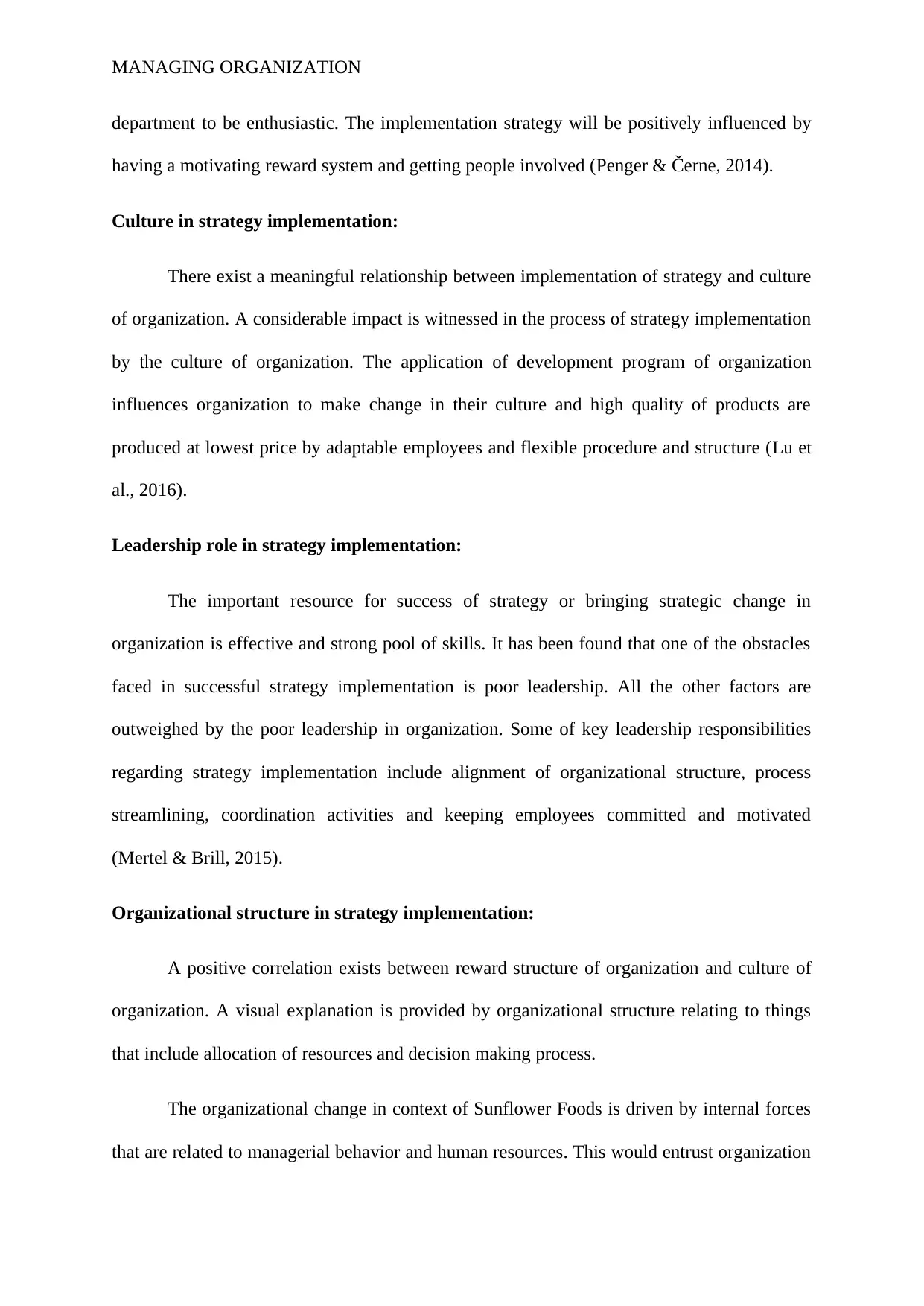
MANAGING ORGANIZATION
department to be enthusiastic. The implementation strategy will be positively influenced by
having a motivating reward system and getting people involved (Penger & Černe, 2014).
Culture in strategy implementation:
There exist a meaningful relationship between implementation of strategy and culture
of organization. A considerable impact is witnessed in the process of strategy implementation
by the culture of organization. The application of development program of organization
influences organization to make change in their culture and high quality of products are
produced at lowest price by adaptable employees and flexible procedure and structure (Lu et
al., 2016).
Leadership role in strategy implementation:
The important resource for success of strategy or bringing strategic change in
organization is effective and strong pool of skills. It has been found that one of the obstacles
faced in successful strategy implementation is poor leadership. All the other factors are
outweighed by the poor leadership in organization. Some of key leadership responsibilities
regarding strategy implementation include alignment of organizational structure, process
streamlining, coordination activities and keeping employees committed and motivated
(Mertel & Brill, 2015).
Organizational structure in strategy implementation:
A positive correlation exists between reward structure of organization and culture of
organization. A visual explanation is provided by organizational structure relating to things
that include allocation of resources and decision making process.
The organizational change in context of Sunflower Foods is driven by internal forces
that are related to managerial behavior and human resources. This would entrust organization
department to be enthusiastic. The implementation strategy will be positively influenced by
having a motivating reward system and getting people involved (Penger & Černe, 2014).
Culture in strategy implementation:
There exist a meaningful relationship between implementation of strategy and culture
of organization. A considerable impact is witnessed in the process of strategy implementation
by the culture of organization. The application of development program of organization
influences organization to make change in their culture and high quality of products are
produced at lowest price by adaptable employees and flexible procedure and structure (Lu et
al., 2016).
Leadership role in strategy implementation:
The important resource for success of strategy or bringing strategic change in
organization is effective and strong pool of skills. It has been found that one of the obstacles
faced in successful strategy implementation is poor leadership. All the other factors are
outweighed by the poor leadership in organization. Some of key leadership responsibilities
regarding strategy implementation include alignment of organizational structure, process
streamlining, coordination activities and keeping employees committed and motivated
(Mertel & Brill, 2015).
Organizational structure in strategy implementation:
A positive correlation exists between reward structure of organization and culture of
organization. A visual explanation is provided by organizational structure relating to things
that include allocation of resources and decision making process.
The organizational change in context of Sunflower Foods is driven by internal forces
that are related to managerial behavior and human resources. This would entrust organization
⊘ This is a preview!⊘
Do you want full access?
Subscribe today to unlock all pages.

Trusted by 1+ million students worldwide
1 out of 17
Related Documents
Your All-in-One AI-Powered Toolkit for Academic Success.
+13062052269
info@desklib.com
Available 24*7 on WhatsApp / Email
![[object Object]](/_next/static/media/star-bottom.7253800d.svg)
Unlock your academic potential
Copyright © 2020–2025 A2Z Services. All Rights Reserved. Developed and managed by ZUCOL.





